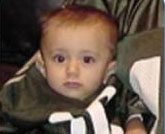A handful of retailers and their champion, U.S. Consumer Product Safety Commission(CPSC) Commissioner Anne Northup, are crying out about this week’s historic new tough standard and ‘stop sale’ on unsafe cribs. They found themselves ‘stuck’ with cribs that couldn’t meet the tough new standards and are unhappy that they couldn’t keep selling noncompliant cribs after the deadline.

Bobby
We sympathize with the tough business climate right now; after all, our families are equally affected by the economic situation. But to suggest that ‘just a few more months’ to sell through inventory is a request CPSC should honor, flies in the face of what we know about cribs and their safety.
Our sons died in cribs that were certified as ‘safe’ by their manufacturers and the Juvenile Product Manufacturers Association (JPMA). The cribs were sold by retailers whom we are sure thought they were safe. And yet Tyler, Bobby and Liam are gone – killed by their cribs.
Now these retailers and Commissioner Northup assure us that the cribs they want to continue to sell are ‘safe.’ But you can’t tell the safety of a crib by looking at it and you certainly can’t maintain its safety because it met weak industry standards in place prior to 2010. 12 million cribs recalled in the last four years and those that killed our sons also met those same inadequate standards.
For 10 years, improvements to the voluntary crib standard were stonewalled by industry. Finally, after the mounting death toll and recalls, the industry in 2009 agreed to stop making drop-side cribs – although at the same time talked out of both sides of their mouths and said they were safe. But that one change in design in the 2009 standard did nothing to address the durability of cribs and the quality of their hardware and materials. Our sons died in faulty drop-side cribs. But it was the hardware that failed – the same hardware holding fixed sided cribs together and holding up mattresses. Ask Andrew Hartung whose daughter’s hand was crushed in between the corner post and side of her crib when the attachment point failed. Or ask the parents of Landon who died when the mattress support failed on his crib, trapping him in much the same horrifying way that the drop-sides trapped our sons. While the drop-side design was the most likely to fail, the underlying problem was durability, hardware integrity and design. The new mandatory standard, unlike the 09 ASTM standard, addresses all these issues.
Because industry wouldn’t act, Congress in the Consumer Product Safety Improvement Act of 2008 did. That legislation required these new standards and the mandate that retailers stop selling the old unsafe cribs once the new cribs were available.
For some retailers to want to continue selling out their inventory for a few more months might seem reasonable, but think about the long term impact. Those cribs will remain in use for up to 10 years or longer. The hidden flaws that the weak industry testing didn’t catch will lie in wait for a baby – 3 years from now, and 5 years from now.
It is time to stop now. And most retailers and manufacturers – the vast majority of them – were prepared. New cribs are in stores now and consumers can buy them with confidence.
While Northup asks, “What’s the rush?” we ask “why has it taken so long?” We can’t go back and save our sons, but we are so grateful that CPSC has finally acted to save other children. There are others who can argue that the economic boost of starting the market for cribs at a zero point and needing to fill that demand will more than offset the losses of these firms who misjudged the number of cribs they might sell quickly. But for us, for the legacy of our sons, safety has to come first.
Susan & Robert Cirigliano
Michelle & Henning Witte
Nicola & Chad Johns



